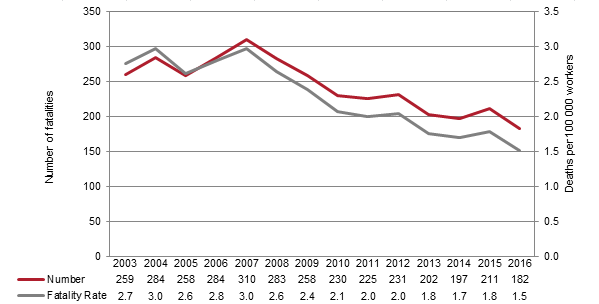Mental health care sketch diagram
Are we looking at safety the right way? The workplace fatality rate over the past decades has halved (refer to graph), and whilst every death is one too many, maybe we’re looking at the wrong areas (particularly in bang for our bucks we have hit the wall of diminishing returns) to further improve the wellbeing of our people? In 2018, 149 Australians died whilst at work (39% of which were vehicle collisions, and is no doubt driving the technological uptake of automated driving systems). By comparison, there were 1,146 deaths on our roads, and a whopping 3,128 suicides in our society. Mental health is therefore a much greater issue than workplace health and safety but gets much less attention.
Figure 1: Worker fatalities: number of fatalities and fatality rate, 2003 to 2016

(Image sourced from: Safe work Australia)
Of course, suicide is at the extreme end of the mental health scale, and all persons move along the mental health scale daily depending on what happens around us. I’m not suggesting that employers should have to shoulder the whole burden of improving mental health, but we can play a part. In fact, I’m convinced that Australian companies’ greatest contribution is to provide employment in the first place, as unemployed people have a suicide rate 4.62 times higher than for employed people. And this is where it gets tricky – the causes of suicide are complex. The experts narrow it down to stresses in life; mental and physical illness; drug and alcohol abuse; and poor living conditions. Employers can only influence perhaps a couple of those areas, and only to a limited extent.
Australia’s overall starting point is reasonably strong: we have a suicide rate of 5.7 per 100,000 people compared to the World Health Organisation average of 11.7. But there are substantial differences between sectors in our community.
75% of suicides are male, and the construction and mining industry (largely male dominated) has a suicide rate double the average occupational rate. The Agriculture, Forestry and Fishing industry is sadly 4 times higher again – probably largely attributed to drought (and we still don’t build dams to help…). In other words, employees in our industries are at greater risk than most other employed persons, giving us some scope to improve.
I was fortunate enough to be part of a presentation on Mental Health by Beyond Blue recently, and the most memorable part was when an experienced manager in the audience shared that they recently had an employee commit suicide. Nobody saw it coming – not even the persons partner who was a Mental Health practitioner. If they can’t see the signs, what hope is there for the rest of us?
From my research, there are still areas where employers can help not only reduce suicide, but positively impact on employee wellbeing. It doesn’t have to mean a great investment for the business, with research indicating mentally healthy employees take less days off sick and have higher productivity. Each dollar spent on employee wellbeing is said to generate a $2.30 return. Poor mental health costs Australian businesses $10.9 billion per year in lost productivity, absenteeism and compensation claims.
Whilst this information wasn’t the driver, RDW recently embarked on a health and well being initiative for our employees and joined the Virgin Global Challenge. It is a 100-day step challenge, together with goal setting, nutrition and other individual wellness parameters. It’s certainly created a vibrant buzz around our business, with an amazing 80% take-up rate. Apart from seeing an increase in physical activity, the biggest gain is the increased interaction between all the participants and the friendly banter.
A significant portion of mental health issues are of course outside of the workplace, often centred around the home life. We’ve always believed that when you employ a person, in effect you employ their whole family. There are of course many things employers can do to help improve employee wellbeing, and I believe employers are at the forefront by providing things like supportive social relationships; giving people a sense of purpose, control and harmony; and not least by alleviating financial pressures.
Where businesses perhaps fall short is in identifying people who may need help and are afraid to ask or don’t know how to find it. Most managers also lack the skills for dealing with the situation. Much like the person requiring the help, this is probably where businesses need to “outsource” the issue to a mental health professional.
In conclusion, much (if not most) of the issues causing Mental Health issues are outside the workplace, and there might not be much we can do to influence people outside of work. But let’s provide workplaces where social interaction is improved by encouraging some fun, and give people the sense of satisfaction that comes from making a productive difference. A happy, efficient workplace will then give companies the resources to continue financially supporting more people – creating a positive cycle that improves the mental and physical health even further.
As always, onwards and upwards!
Fred Carlsson
General Manager



